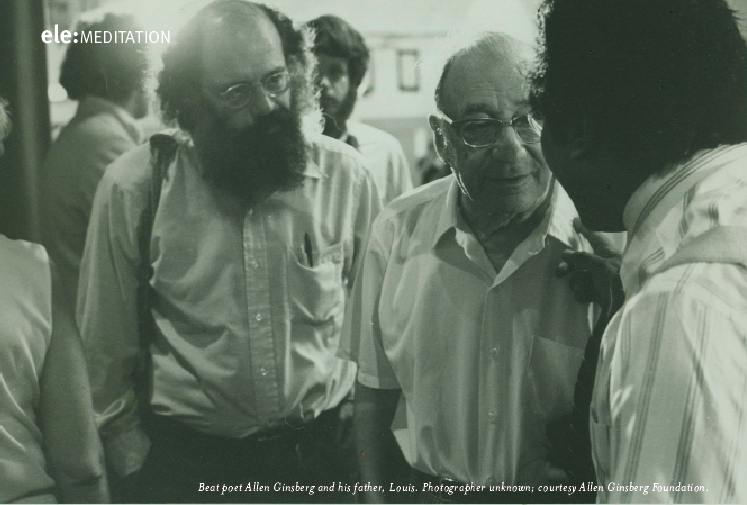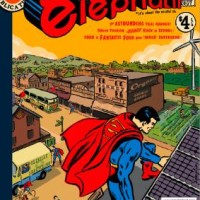Photo of Allen Ginsberg and his father, Louis Ginsberg, with Chogyam Trungpa, courtesy the Allen Ginsberg Foundation.
“Art and Environment,” via Chogyam Trungpa, Rinpoche, from the Holiday 2008/9 issue.
Chögyam Trungpa Rinpoche and his students founded Naropa University in 1974 as a place to present Buddhist teachings and practice, and also as a place where various artistic, spiritual and academic disciplines could come together in a sparky environment that merged intellect and intuition. At Naropa, Rinpoche gave many talks on Buddhist iconography and making a genuine meditative or contemplative connection to art, which he called “dharma art.”
Even as a child, Trungpa Rinpoche was interested in art. He became a master calligrapher, he studied Japanese flower arranging, or ikebana, and had many art shows and installations in which he showcased his work. He was also passionate about poetry and poets. Allen Ginsberg and Anne Waldman were both his students, as well as being co-teachers with him at Naropa. In this issue of elephant, we present remarks by Trungpa Rinpoche on art, from a talk at Naropa in 1979, along with several of his short, haiku-like poems from the same year. ~ Carolyn Gimian.
Art is a rather vast subject. In connection with human development all together, art includes the practice of meditation, learning about ourselves and discovering the nonexistence of our ego. We sometimes speak of art as “secular.” In my vocabulary, the word “secular” means “without dogma.”
This means that we can relate with our bread-and-butter situation, with our breakfast, lunch and dinner. In fact, breakfast, lunch and dinner are sacred. That everyday sacredness is where the concept of art comes from. It is spiritual but not necessarily religious.
Art is environment. Education is the mind which relates with that environment. Whatever we do in the course of our life—depositing money in the bank, cashing a check, making business deals, cooking breakfast, preparing a party for our friends, buying a new hat, mending our clothes, stopping at the gas station to fill up our cars—any activity that is part of the spectrum of our life is art, very much art. Art is environment because we are capable of doing all those things properly.
Often we couldn’t care less about these things. We just do them randomly. Our attitude is to do them mindlessly and get them out of the way. Sacredness is our capability for doing all those things with awareness. You have the capability of eating breakfast, you have the capability of mending your clothes; you have the capability of putting your clothes in the washing machine and your dishes in the dishwasher. You have all those capabilities and you don’t mix things up. You know what you are doing. You have that much awareness.
All your activities are regarded as expressions of basic intelligence or basic goodness. You possess the discriminating-awareness wisdom that allows you to do what you want. If you go to a lecture, you don’t think you are going to a gas station or a restaurant. You know where you are. That logic may seem very small and naïve, but it makes sense. You manage to arrive at a particular place at a particular time, you wear certain clothes and you sit in a particular seat. You listen to the speaker and try to understand what is being said. That in itself is creating a work of art. It is an expression of what in the Buddhist tradition we call prajna, which means “the best of knowledge.” Basic integrity means knowing what you’re doing. In the creation of art, that basic integrity or knowing takes place very powerfully, along with some sense of your basic goodness. Everybody is good; everybody possesses basic goodness—for the very reason that you are here, alive. You are willing to share the feast of your intelligence and your sanity with others, and that is astounding and extraordinary. On the other hand, it is very ordinary.
We have an expression, “ordinary mind” and another expression, “the best of mind,” or “the greatest insight.” Both mean exactly the same thing. They both come to one conclusion: whatever you do is an expression of basic goodness in you. You might be skeptical about that, but at the same time, in your heart, you are tickled and open and wondering. You possess that kind of presence, which you project—all of you. You have something going on that in simple, ordinary language we call “basic goodness.”
It makes you feel good. A baby may cry, but she cries very wholeheartedly.
Art is not merely being able to do your music or your painting or your little arrangements or installations of this and that. The kind of art we are talking about is big art. It is having basic goodness in an environment, which in itself is a work of art. It is really worth cheering up tremendously.
Chögyam Trungpa Rinpoche’s column is based on teachings selected by Carolyn Gimian. Check out the recently released Ocean of Dharma: The Everyday Wisdom of Chögyam Trungpa, which presents 365 short teachings on living life with courage and compassion.
 Share on bsky
Share on bsky


Read 15 comments and reply